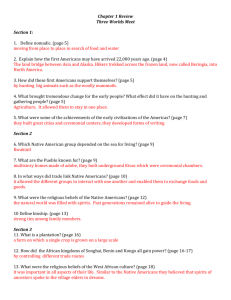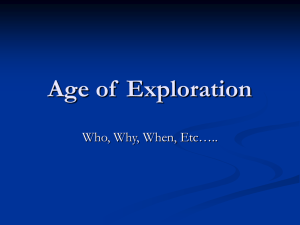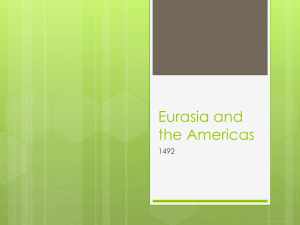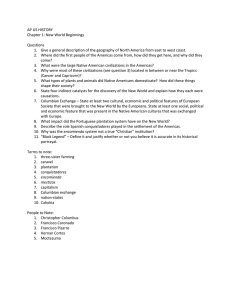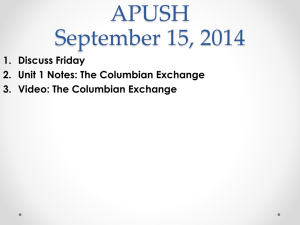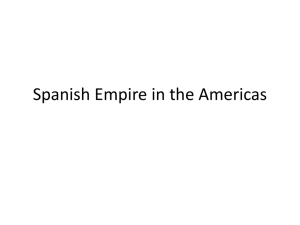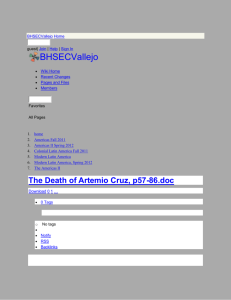Columbian Exchange
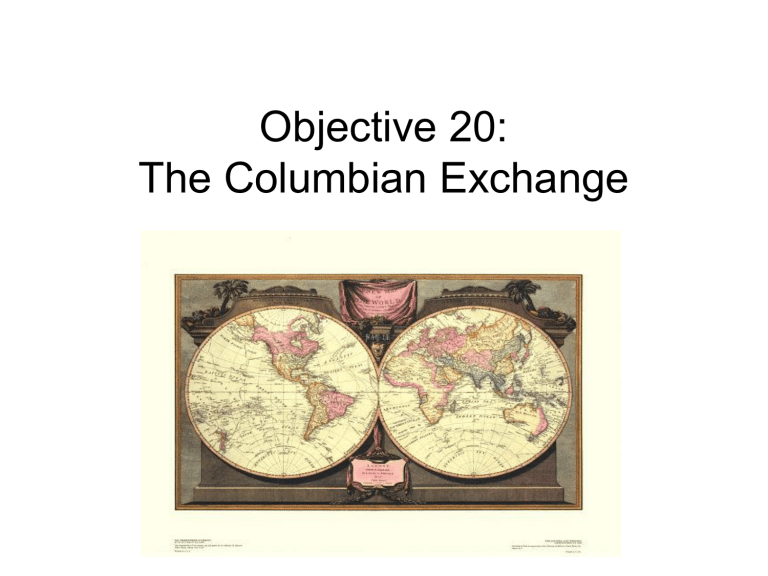
Objective 20:
The Columbian Exchange
Should Columbus Day be celebrated as a national holiday?
Voyages of Christopher Columbus
• Under the sponsorship of the Spanish crown, headed for Asia by sailing west
• Landed in the Bahamas
• Made four voyages altogether
• Didn’t find gold or spices
• Did find a “new world”
Columbus Landing at Guanahani, 1492
1837-47 Rotunda, US Capitol, Washington
John Vanderlyn, an American whose revolutionary sympathies had led him to study and work in Paris in the early days of the empire, executed this painting in the American Capitol in Washington. His theme was
Columbus Landing at Guanahani, 1492, glorifying the arrival on this West Indian island of the historical figure who was regarded as the founder of the white and Christian Americas. His Indians crouch like wild animals, frightened and puzzled, and some of the explorer's Spanish sailors crawl on the ground, already hunting for gold.
The four voyages of Christopher Columbus.
He “discovered” “Hispaniola” [Haiti/DR] and the
“Indians.”
Seven Myths of Spanish
Conquest
• “Exceptional Men”
• “The King’s Army”—Neither paid nor forced.
• “White Conquistadors” – Invisible Allies
• “Spanish Conquest” – Myth of Completion
• “The Myth of (Mis) Communication”
• The Myth of Indian Desolation
• The Myth of Superiority
What Really Happened?
• Disease
• Native disunity
• Weapons – guns, steel, horses, war dogs, tactical skills, especially the steel sword
• Culture of War
• Global context of an age of expansion
Pre-Columbian America.
Pre-Columbian America had two great regions of trade and political power. In the north, the Aztec kingdom, centered on Tenochtitlán, dominated.
The adjacent Maya of Central
America were in decline. In
South America, about 1500, the Inca dominated the Andes mountain regions, linking them together through an extensive system of roads.
Conquest of Mexico
• 1519-1521 conquered the Aztec empire with only 450 men
• How?
– Superior weapons
– “Divide and conquer”
– Disease
Hernán Cortés
Broken spears lie in the roads;
We have torn our hair in our grief.
The houses are roofless now, and their walls
Are red with blood…
Elegy for Tenochtitlan
Cortes with Doňa Marina a.k.a. “Malinche”
Conquest of the Incan Empire
• 1530-40 conquered the Incan empire with only 600 men
The “Columbian Exchange”
TE : “…the global diffusion of plants, food crops, animals, human populations, and disease pathogens that took place after voyages of exploration by Christopher Columbus and other European mariners...”
Three main aspects of the
Columbian Exchange
• Biological exchanges
• Dietary exchanges
• Human migration
Biological exchanges
• Prior to Columbus’s voyages, Eurasia was
“thoroughly diseased” and the Americas had been in relative “biological isolation.” Why?
• Contact among cultures of Eurasia had been much more intense over the centuries.
• Eurasians had a long history of domesticating animals —a source of disease.
Diseases exchanged:
• Eurasia Americas:
– Smallpox, measles, diphtheria, whooping cough, influenza
• Americas Eurasia:
– Syphilis?
Consequences of biological exchanges:
• Devastation of native populations of the
Americas and
Oceania.
• Within one century, some native populations declined
95%!!!!
Images of Aztec smallpox victims.
Between 1500 and 1800 approximately one hundred million people* in the Americas and
Oceania likely died of imported diseases.
*The current population of the U.S. is 300 million so this was equivalent to 1 in 3
Americans living today.
Dietary exchanges
• Americas Eurasia
– “New World Crops-
– Maize, potatoes, beans, tomatoes, peppers, peanuts, manioc, papayas, guavas, avocados, pineapples, cacao, tobacco
Eurasia Americas
– “Old World”
– Wheat, horses, cattle, pigs, sheep, goats, chickens
The incredible potato!!!
Export of Tobacco from Virginia
300000
250000
200000
150000
100000
50000
0
Pounds
1616 1624 1638
“Drug and Taste Revolution”
Consequences of dietary exchanges:
• More balanced diets globally
• Increased calories in Eurasian diets the amazing potato and also maize
• Basis of “national” foods and customs tomatoes to Italy, spices to China, horses and cattle to the Americas
• A surge in global population!
Population increases:
World population:
• 1500: 425 million
• 1600: 545 million
• 1750: 720 million
• 1800: 900 million
World population more than doubled in three hundred years!!
This more than offset population losses due to disease.
900
800
700
600
500
400
300
200
100
0
World Population Growth, 1500-
1800 CE
Millions
1500 1600 1700 1800
Human migration
The massive de-population of the Americas due to conquest and disease:
• Enabled European migration and colonization
• Compelled forced migration of slaves from
Africa
Sugar and
Slavery
“Every ton of sugar represented a life; every teaspoonful represented 6 days of a slave’s life.”
African Slave Exports per Century
60000
50000
40000
30000
20000
10000
0
16th c.
17th c.
18th c.
Destination of Africans in the
Atlantic Slave Trade
5%
12%
50%
Caribbean
Brazil
Central, South America
North America
33%
The “Atlantic System”
Slave trade
• Transfers African culture to the Americas
• Between 1450 – 1850 it is estimated 12 million Africans were shipped across the
Atlantic Ocean
• Portuguese and then Dutch, English, and
French
• European agents made agreements with local leaders to traffic slaves
• Enormous profits – up to 300 % on a voyage
• Sugar plantation labor
Manila galleon route and the lands of Oceania, 1500-1800
European exporation in the Pacific
Ocean, 1519-1780.
European trading posts in Africa and Asia, about 1700
European empires and colonies in the
Americas c. 1700
Economic Impact
• Gold and silver from America to Europe – who uses it to buy Asian goods
• Rise of the European commercial class and decline of the aristocracy
• Europe becomes the center of the world market
Some long-term effects of the Columbian Exchange:
• Creation of a global economy for the first time in human history
• European colonization of the Americas
• European Empires-beginning of “westernization”
• Cultural changes – Latin America, Atlantic Civilization
• Global population growth
• Permanent depletion or loss of many native American and
Oceanic cultures
• Uneven consequences around the globe
European exploration, 1450 –1600.
Spanish and Portuguese explorers and traders had established settlements in South America and the Caribbean by 1600, and commercial depots on the coasts of Africa, India, the Pacific islands, China, and Japan —at a time when
English, Dutch, and French explorations of North America had just begun.
World exploration.
The limitations on sea routes through the Middle East drove the trading nations of western Europe to seek alternate maritime passages to Asia. European navigators and cartographers rapidly built a map of the globe which included, by sailing west, the “New World” of the Americas and, by sailing south, a passage around Africa, linking with the Arab trading routes of the Indian Ocean. The voyages of the Ming Chinese admiral Zheng He were undertaken to demonstrate China’s strength even more than for trade.
